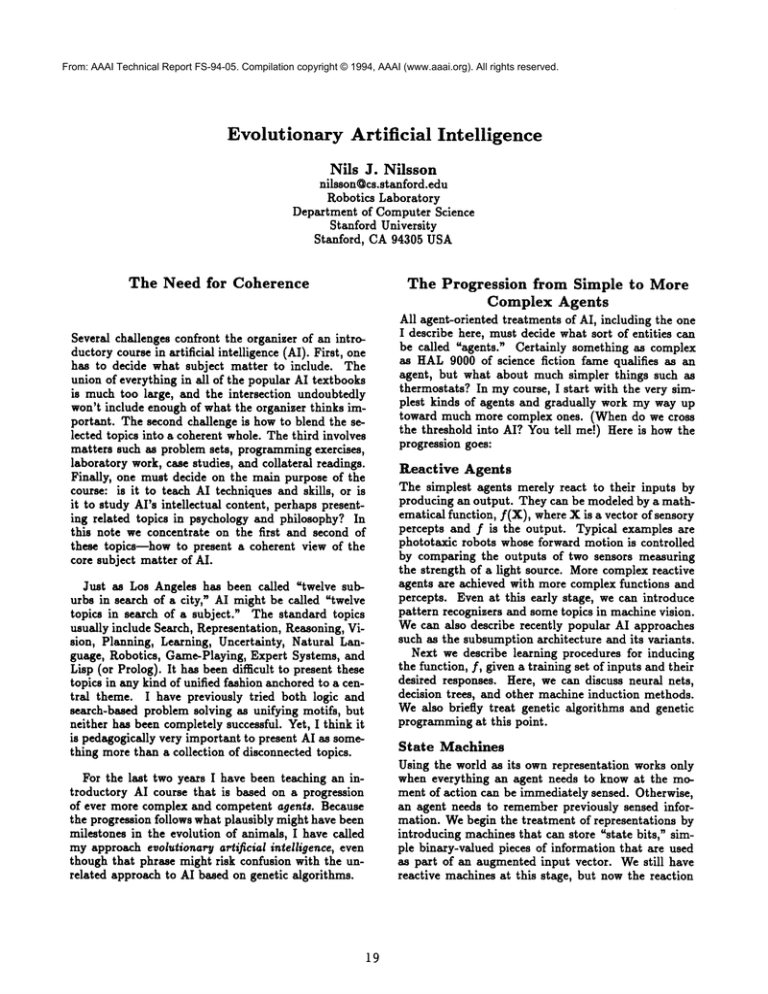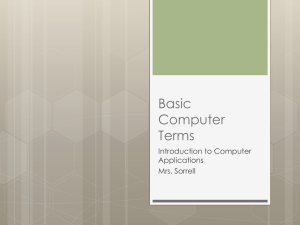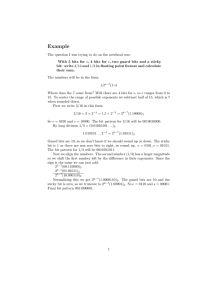
From: AAAI Technical Report FS-94-05. Compilation copyright © 1994, AAAI (www.aaai.org). All rights reserved.
Evolutionary
Artificial
Intelligence
Nils J. Nilsson
nilsson@cs.stanford.edu
Robotics Laboratory
Department of Computer Science
Stanford University
Stanford, CA 94305 USA
The Need for Coherence
The Progression from Simple to More
Complex Agents
Several challenges confront the organizer of an introductory course in artificial intelligence (AI). First, one
has to decide what subject matter to include. The
union of everything in all of the popular AI textbooks
is much too large, and the intersection undoubtedly
won’t include enough of what the organizer thinks important. The second challenge is how to blend the selected topics into a coherent whole. The third involves
matters such as problem sets, programming exercises,
laboratory work, case studies, and collateral readings.
Finally, one must decide on the main purpose of the
course: is it to teach AI techniques and skills, or is
it to study Ars intellectual content, perhaps presenting related topics in psychology and philosophy? In
this note we concentrate on the first and second of
these topics--how to present a coherent view of the
core subject matter of AI.
Just as Los Angeles has been called "twelve suburbs in search of a city," AI might be called "twelve
topics in search of a subject." The standard topics
usually include Search, Representation, Reasoning, Vision, Planning, Learning, Uncertainty, Natural Language, Robotics, Game-Playing, Expert Systems, and
Lisp (or Prolog). It has been difficult to present these
topics in any kind of unified fashion anchored to a central theme. I have previously tried both logic and
search-based problem solving as unifying motifs, but
neither has been completely successful. Yet, I think it
is pedagogically very important to present AI as something more than a collection of disconnected topics.
For the last two years I have been teaching an introductory AI course that is based on a progression
of ever more complex and competent agenf8. Because
the progression follows what plausibly might have been
milestones in the evolution of animals, I have called
myapproach e~olu~ionary artificial intelligence, even
though that phrase might risk confusion with the unrelated approach to AI based on genetic algorithms.
19
All agent-oriented treatments of AI, including the one
I describe here, must decide what sort of entities can
be called "agents." Certainly something as complex
as HAL9000 of science fiction fame qualifies as an
agent, but what about much simpler things such as
thermostats? In mycourse, I start with the very simplest kinds of agents and gradually work my way up
toward much more complex ones. (When do we cross
the threshold into AI? You tell me!) Here is how the
progression goes:
Reactive
Agents
The simplest agents merely react to their inputs by
producing an output. They can be modeled by a mathematical function, f(X), where X is a vector of sensory
percepts and f is the output. Typical examples are
phototaxic robots whose forward motion is controlled
by comparing the outputs of two sensors measuring
the strength of a light source. More complex reactive
agents are achieved with more complex functions and
percepts. Even at this early stage, we can introduce
pattern recognizers and some topics in machine vision.
Wecan also describe recently popular AI approaches
such as the subsumption architecture and its variants.
Next we describe learning procedures for inducing
the function, f, given a training set of inputs and their
desired responses. Here, we can discuss neural nets,
decision trees, and other machine induction methods.
Wealso briefly treat genetic algorithms and genetic
programming at this point.
State Machines
Using the world as its own representation works only
when everything an agent needs to know at the moment of action can be immediately sensed. Otherwise,
an agent needs to remember previously sensed information. Webegin the treatment of representations by
introducing machines that can store "state bits," simple binary-valued pieces of information that are used
as part of an augmented input vector. Westill have
reactive machines at this stage, but now the reaction
is to the sensed information plus the state bits, and
the output can affect both the world and the value of
the state bits. Agents of this type are Turing equivalent (if we have an unbounded number of state bits),
so further elaborations just make them more efficient.
A more complex form of representation than state
bits is an iconic one. For example, a data structure representing a map of a robot’s environment is an iconic
representation. In order to get information out of a
map (such as is there a doorway connecting rooms 37
and 38.7), routines similar to those used for perceptual
processing are needed. (I’m not sure how precise
can make the distinction between iconic and non-iconic
representations, but I think the intuition is right.) My
agents can nowbase their actions on sensory information, state bits, and on information derived from their
iconic representations. Their actions might also make
changes to the iconic representations.
Planning
What to
Do
There are many ways to implement the input-output
function, f. Anagent might have an explicit table listing the appropriate reaction to every possible input.
Presumably the agent’s designer computed the table
at design time. An alternative is to have the agent do
the computation at run time. For many applications,
neither the table nor a simple functional form is available. What might be available, though, is an action
model that tells the agent what its next input (sensory
plus state bits) would be for any possible action that
it might take, given its current input. Such an agent
can compute an action by trying out various ones in
its model and evaluating their consequences. Thus, we
come to the various search procedures important in
AI---depth-first, breadth-first, A*, and so on. Wealso
take a slight detour here to talk about game-tree or
adversarial search.
According to some authors, an agent becomes autonomous only when it evaluates the consequences of
its actions. Of course, we have no way of knowingfrom
its external behavior whether an agent chooses an action by referring to a table or by a search process--the
matter is purely one of implementational efficiency and
space-time trade-off. Nevertheless, we think of agents
that plan what to do as being more sophisticated than
those that merely react.
Logical
Agents
In addition to having some computational means to
compute output from input, an agent may know that
there are certain constraints or dependencies governing its input. In the simple case in which the input is
a vector, X, it may be that certain vectors are impossible; or, given the values of some of the components,
the agent may be able to computethe values of others.
What is the appropriate language for describing these
constraints and dependencies? Propositional calculus,
of course! Here we lay the groundworkfor logical representation and reasoning--introducing resolution and
the various proof strategies that use resolution. My
agents are now capable of elementary logical reasoning, and we can describe simple expert systems at this
stage of the course.
Movingtoward a more expressive language for representing constraints, we next introduce first-order predicate calculus including, unification and first-order resolution. This point also affords us the opportunity to
introduce Horn clauses, logic programming, and the
trade-offs between expressibility, soundness, completeness, and computational feasibility.
Then, we moveon
to more structured representations such as frames and
semantic networks. Nonmonotonicreasoning is introduced as a formalization of inheritance cancellation in
semantic networks.
Of course, the formalism in which knowledgeis represented doesn’t teU us anything about what ought to
be represented. The exercise of attempting to represent commonsense as well as expert knowledge gives
us a flavor of the problems involved in constructing
ontologies.
Weconfront the fact that much useful information
is uncertain by introducing techniques associated with
probabilistic logic, belief networks, and other related
formalisms. More complex expert systems using these
methods can then be presented.
Planning Using Logical
Descriptions
Having a language in which to describe the effects
of actions (instead of having to model them iconically as we did when we discussed search methods earlier) permits more powerful planning methods. These
methods, based on the situation calculus and STRIPS
rules, leave some matters about the effects of actions
unspecified,
and that is both good and bad. The
bad part is manifested in the frame problem (and
its friends). Wepresent a progression of planning
techniques---culminating in non-linear and hierarchical planning. Our agents are now capable of rather
sophisticated problem-solving behavior, but the computationally feasible ones are prone to various shortcomings associated with the methods they use.
Communication
and Multiple
Agents
Agents must communicate with humans and other
agents. Although there is little material dealing with
specialized agent-to-agent communication languages,
we can discuss here the concepts of speech acts in the
context of planning to affect the cognitive structures of
other agents. These topics underlie our treatment of
natural language processing, which is dealt with next.
Integration
and Agent Architectures
So far we have described agents that react, agents
that reason, agents that plan, and agents that communicate. Nowwe integrate these abilities in robots
2O
and softbots that are much more capable than the
purely reactive agents considered at the beginning of
the course. Various architectures capable of real-time
deliberation are presented.
Summary
and Conclusions
Myevolutionary approach helps tie together aspects
of AI that might otherwise seem disparate. Student
reaction has been positive. Programming assignments
allow students to build their ownprogression of agents.
Stanford uses the ten-week quarter system, but I think
the course would be better matched to a fifteen-week
semester.
Somepeople have criticized an agent-oriented approach to AI---saying there is more to AI than agents.
Perhaps so, but I think that some of these other aspects of AI, such as expert scheduling systems, design
systems, and diagnosis systems are a bit off the track of
what should be the main goal of AI--developing versatile agents that can use these other systems as tools. In
any case, the material presented in mycourse is pretty
muchwhat ought to be in a ~rsg course in AI.
It is a feature of my approach that machine learning is not treated as a separate topic; instead, various
aspects of learning arise throughout the course. Neural nets can be presented early; techniques for learning
search heuristics can be discussed while talking about
search; inductive logic programming and explanationbased learning can be treated toward the end of the
logic block, and learning search control knowledgecan
be presented after discussing logic-based planning.
I am intending to transform my rough lecture notes
for this course into an AI text. Interested people can
contact me in late 1995 for early draft material.
21





